The first Earth Day in 1970 was about several things: 1) putting environmental issues on the map; 2) educating people about the severity of these issues; 3) mobilizing those people to take action; and 4) doing so in celebration of the planet. 53 years later, Aspen Ideas: Climate is about much of the same – creating a space for the critical and urgent issues of today to be discussed in earnest while highlighting the solutions and the people who are driving them, widening and connecting thinkers and doers taking action, and doing so with art, innovation, and inspiration that remind people of what this thing is really all about.
In typical Aspen-style, the EEP team compiled five amazing ideas presented during Aspen Ideas: Climate, recapping of some of our team’s favorite jaw-dropping/a-ha/re-evaluate and re-calibrate moments that we will carry with us throughout the year. The following represent the ideas, words, numbers, and solutions from more than 100 speakers, and we hope that on their own, and taken together, they offer a snapshot of the 2023 climate moment and the possibility that it holds – much of the same hope and opportunity that was the basis for Earth Day over 50 years ago.
1. Biodiversity and Indigenous voices should be part of every climate conversation.
On saving the Amazon rainforest, former President of Columbia Ivan Duque shared that “If the current pattern of deforestation in the Amazon continues, it will no longer be a container of carbon dioxide, but will be a net emitter in less than a decade.” Later, ecologist and conservationist, Gerardo Ceballos, posited that a key solution to this crisis is mainstreaming biodiversity in the climate conversation, as 30% of the task at hand will have to be done through biodiversity conservation and nature-based solutions.
In bringing biodiversity into the climate conversation, Ceballos cited some staggering numbers: Of the species that have become extinct in the last 100 years it would have taken 10,000 years for those species to become extinct under normal circumstances. For example, there were 10 million elephants in the 1900s, only 1.3 million in the 1970s, and just about 300,000 now. With an elephant lost every 30 minutes by illegal trade, there will be no elephants in the wild in 20-25 years, if trends continue. Ceballos equated this species’ loss to taking a brick out of a wall, and in doing so, eroding the capabilities of the planet’s ability to maintain life as we’ve known it.
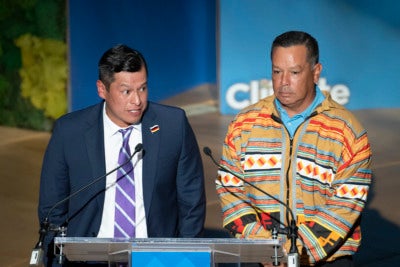 We cannot tackle the climate crisis without conserving biodiversity and by integrating this topic into mainstream conversations about mitigation and adaptation, we can make immense progress towards preserving ecosystems. Throughout the week, a number of speakers also highlighted numerous times that Indigenous people represent only 5% of the world’s population and yet preserve eighty percent of the world’s biodiversity, highlighting their critical role as stewards of the earth and as such, the importance of Indigenous voices leading these conversations.
We cannot tackle the climate crisis without conserving biodiversity and by integrating this topic into mainstream conversations about mitigation and adaptation, we can make immense progress towards preserving ecosystems. Throughout the week, a number of speakers also highlighted numerous times that Indigenous people represent only 5% of the world’s population and yet preserve eighty percent of the world’s biodiversity, highlighting their critical role as stewards of the earth and as such, the importance of Indigenous voices leading these conversations.
2. “The tools that got us here are not the tools that will get us out of this mess,” Kate Orff on rethinking our ecosystems and the climate innovation we must deploy.
Regenerative Ocean Farming
Seaweed can absorb massive amounts of carbon and protect shorelines by reducing wave energy and a single oyster can filter up to 50 gallons of water a day, allowing seagrass and other habitats to thrive in that cleaner water. Champions for regenerative ocean farming argued for the promise of this emerging industry and the work that we can do to: increase education and demonstrate that aquaculture, and other forms of ocean farming are viable career paths; support the industry with our dollars by choosing sustainable seafood options and kelp, for example, in our grocery stores; and contribute to the shift in narrative that aquaculture can work together with (not in competition with) traditional fisheries, so that communities buy-in to this diversification strategy. For example, traditional fishermen might grow kelp in the winter when they are catching lobster in the summer, rather than opposing this emerging industry altogether.
Infrastructure
Worldwide, 39% of emissions come from buildings. Architect Michael Green posited that we could mitigate these emissions if we just let nature teach us how mass timber–an engineered material that binds together wood fibers in an industrial process– can be used to build skyscrapers as an alternative to steel and concrete, reducing this enormous carbon footprint. And in the case globally, where sustainable forestry is not accessible, biomaterials like grasses, bamboo, and other plants can and will be the building materials of our future.
Food Waste
⅓ of the food produced in the United States is never eaten and when it goes to landfill, it releases methane, positioning food waste emissions as the third largest emitter behind China and the U.S. in terms of total emissions if it were a nation. But Matt Rogers shared a solution to these emissions. His idea and company produce trash bins that dry and grind food, which is then shipped back to farms where it can be an ingredient for chicken feed.
Extreme Heat
More than a third of all heat-related deaths are now attributed to climate change, and lower-income, marginalized communities, especially women and girls, are often most at risk. Chief Heat Officers stressed our focus should be on public spaces to address extreme heat, planting trees for shade, and increasing access to air conditioning and other cooling methods in these especially vulnerable communities. In Freetown, Sierra Leone, Eugenia Kargbo, shared their efforts to create shade in public markets, where most facilities don’t have air conditioning and their Freetown Treetown initiative, which aims to plant one million shade-creating trees that reforest Freetown and improve health outcomes for its communities.
Plastic Waste
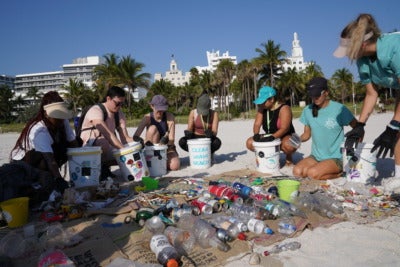 For every person on the planet, there are 21,000 pieces of plastic today and within six years that will double. In other words, we are drowning in plastic, and while we are working to drive ambition in global agreement to end plastic pollution, there are other innovative alternatives our speakers suggested. Plastic is also petroleum, and over the next 20 years, British Petroleum projects plastics will represent 95% of net growth and demand for oil so oil is betting on plastic to save itself. Sway, however, is using seaweed to replace plastics, an approach which centers regeneration as seaweed grows on every coastline in the world, there are 12,000 + species, all of which contain natural polymers that can be combined with starches and sugars and extruded into films, to create the plastic of our future.
For every person on the planet, there are 21,000 pieces of plastic today and within six years that will double. In other words, we are drowning in plastic, and while we are working to drive ambition in global agreement to end plastic pollution, there are other innovative alternatives our speakers suggested. Plastic is also petroleum, and over the next 20 years, British Petroleum projects plastics will represent 95% of net growth and demand for oil so oil is betting on plastic to save itself. Sway, however, is using seaweed to replace plastics, an approach which centers regeneration as seaweed grows on every coastline in the world, there are 12,000 + species, all of which contain natural polymers that can be combined with starches and sugars and extruded into films, to create the plastic of our future.
These innovations represent only a small sample of the hundreds of creative solutions shared on stage, and in the words of renowned rock climber and athlete-activist, Tommy Caldwell, “If there is one thing climbers are all about, it is imagining improbable solutions and making them a reality.” Now is our time to make these, and the multitude of other “improbable” solutions a reality.
3. There are many roads to Damascus when it comes to climate communication.
Founder and Director of the Yale Program on Climate Change Communication, Anthony Leiserowitz, offered that there are many ways to tell a story, and we must meet people where they are and offer them their own paths when communicating about climate and telling the stories of climate change. Climate storytellers, shared that this starts and ends with people, not policy, and how you engage whole people, emotionally, is at the heart of effective storytelling. They described the cardinal rule of climate communication – to know your audience and who they trust for their information. In reaching these various audiences, five key ideas should be incorporated into each story: Scientists agree, It’s real, It’s us, It’s bad……But there’s hope! These are the conclusions that storytellers should draw from their audiences in the thousands of various ways of telling stories, especially this hope, which the news media generally fails to portray.
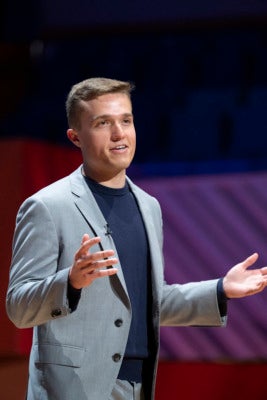 In this vein, conservative conservationist, Benji Backer, urged audiences to view climate as a unifying force, rather than a polarizing one. “Treat your opponent as if they are an intelligent, worthy person operating in good faith.” Formerly a self-proclaimed ‘climate skeptic’, Bret Stephens, urged a similar stance based on his own experience with oceanographer John Englander after witnessing the effects of glacial melting and consequently changed his mind on climate change. Stephens encouraged the audience to take this same measured approach with those with different opinions. Stephens and Englander shared that if you engage people on points of facts and by using plain language, rather than trying to impress with jargon (even the word mitigation is confusing and has many meanings), scientists can widen the net of people who understand and care about climate.
In this vein, conservative conservationist, Benji Backer, urged audiences to view climate as a unifying force, rather than a polarizing one. “Treat your opponent as if they are an intelligent, worthy person operating in good faith.” Formerly a self-proclaimed ‘climate skeptic’, Bret Stephens, urged a similar stance based on his own experience with oceanographer John Englander after witnessing the effects of glacial melting and consequently changed his mind on climate change. Stephens encouraged the audience to take this same measured approach with those with different opinions. Stephens and Englander shared that if you engage people on points of facts and by using plain language, rather than trying to impress with jargon (even the word mitigation is confusing and has many meanings), scientists can widen the net of people who understand and care about climate.
4. Collaborate; seek out unlikely partners; but do so at the speed of trust.
Maritime Shipping Decarbonization
On Aspen Ideas: Climate mainstage, the Aspen Institute, Amazon, Patagonia, and Tchibo, announced the launch of Zero Emission Maritime Buyers Alliance (ZEMBA), a coalition through which freight buyers will accelerate the commercial deployment of zero-emission shipping, enable economies of scale, and help minimize maritime emissions. By working together, ZEMBA members will offer committed demand to build confidence among investors, carriers, ship owners, and producers of zero-emission fuels and renewable energy.
Wildfire Resilience
The Aspen Institute and The Nature Conservancy believed that a paradigm shift was essential to shift how the nation approaches wildfire and launched their Roadmap for Wildfire Resilience to address worsening wildfires in the West on the Aspen Ideas: Climate stage. Success in implementing these recommendations will require trust and community buy-in and a willingness to invest in an all-inclusive approach to problem-solving. The U.S. Department of Agriculture Secretary, Tom Vilsack, supported this paradigm shift and recommendations, also calling for coalition building to get young people involved in farming and engaging rural and urban communities in conversation to re-discover common ground and trust in one another.
Faith
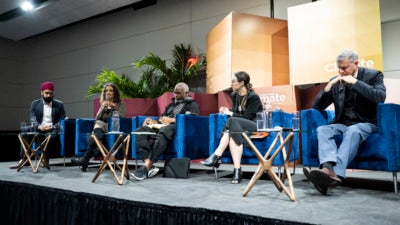 Religious leaders from across faith traditions shared that no matter the religion or denomination, faith can be a powerful lever in climate conversations, as it is inherently prosocial, motivating, and ready-made to scale. Further, the sense that faith-based people, particularly Christians, are not welcome in the movement just narrows the web of climate actors, unfairly so as many religions already espouse values and ethics around caring for the earth. Instead, faith leaders suggest that we use this lever to have an everybody in, nobody out approach to addressing climate change.
Religious leaders from across faith traditions shared that no matter the religion or denomination, faith can be a powerful lever in climate conversations, as it is inherently prosocial, motivating, and ready-made to scale. Further, the sense that faith-based people, particularly Christians, are not welcome in the movement just narrows the web of climate actors, unfairly so as many religions already espouse values and ethics around caring for the earth. Instead, faith leaders suggest that we use this lever to have an everybody in, nobody out approach to addressing climate change.
Community
Again and again, speakers noted that community member engagement is crucial in the decision-making processes for developing renewable energy infrastructure and carbon dioxide removal technologies, implementing wastewater solutions, especially in rural communities, and talking about critical minerals with Indigenous and other communities who have been significantly harmed or exploited by previous mining efforts. Speakers called for audiences to rethink how we are having these conversations and bring in communities earlier in the process for long lasting change.
In bringing these communities into planning and implementation processes and building trust, we should also center dignity rather than focusing on numbers, dollars, and property. Colette Pichon Battle summed this up on the topic of managed retreat from her unique perspective as an advocate for her community in Louisiana, the first state to get federal funding for relocation based on climate change’s effects.
“I am not worth more than you, and you are not more than me, let’s go at this together, and that is the possibility we have in this moment.”- Colette Pichon Battle.
5. Young people are the future so let’s prepare them to meet this challenge.
250 Future Leaders from the Aspen Institute’s Future Leaders Climate Initiative convened in the days before Aspen Ideas: Climate to learn from and network with one another. 10 of those leaders had the opportunity to meet Vice President Kamala Harris and offer recommendations and provide concrete ideas for how the Biden-Harris Administration can place young climate leaders in positions of influence across the federal government. Their ideas included the creation of a youth-specific campaign under Justice 40, incorporating more youth perspectives in the USDA Equity Commission to connect retiring farmers with landless farmers and farmworkers, and providing stipends for young people working jobs that meet specific sustainability criteria. In Vice President Harris’s mainstage talk with Gloria Estefan, she emphasized the optimism she found in these young leaders, in contrast with the hopeless “doomerism” that is often associated with Generation Z.
According to a survey in the Washington Post, only 14 percent of teens feel like they’re learning a lot about climate change in school, though many are hearing about the climate crisis from the media and social media.
Vice President Kamala Harris also highlighted the role that schools must play in addressing climate, noting that 25 million children a day go to school on diesel-fueled buses (90% of the current school bus fleet). Electric school bus manufacturing can create jobs and the buses will reduce the negative health impacts associated with diesel fuel for kids, a majority of which are lower income. Further, beyond the 480,000 school buses within the K-12 system, there are 100,000 school buildings and seven billion meals served per year that could benefit from the sector taking climate action. Within the schools themselves, there is also tremendous opportunity to better educate and equip students to handle climate change.
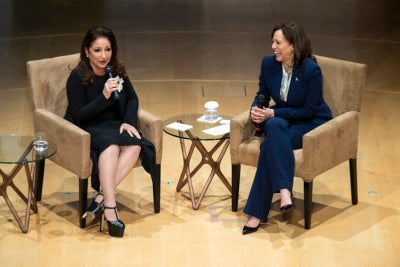
This list of big ideas represents the start of where the magic truly begins for us at EEP. We would need a much longer list of more than just five ideas to capture everything Aspen Ideas: Climate taught us, but one thing remains true: While much of this synthesis represents ideas, initiatives, or policy recommendations that were shared and amplified to an audience of over 2,000 people, so much of Aspen Ideas: Climate was about the ideas and unlikely partnerships that were created along the way.
This Earth Day, we encourage other thinkers and doers to consider every possible climate solution, work collaboratively to take action, and stay hopeful that a better future is right on the other side of the next great idea.
All photos by Daniel Bayer.

